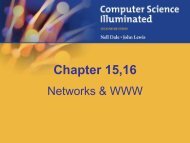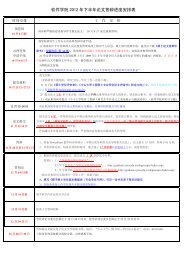Multimed Tools Applcase 4.2:case 4.3:if |d 1 | > T & |d 2 |≤Trange g ′i+1= [ max ( g i+2 − T, g i + T + 1 ) ],...,g i+2if |d 1 |≤T & |d 2 | > Trange g ′i+1= [ g i ,...,min ( g i+2 − T − 1, g i + T )]Please note that the range range g ′i+1is independent of the original <strong>pixel</strong> <strong>value</strong>g i+1 in all cases. And what’s <str<strong>on</strong>g>more</str<strong>on</strong>g>, it can be proven that the sort order and therelati<strong>on</strong>ships as menti<strong>on</strong>ed previously will be preserved for all gi+1 ′ ∈ range g i+1 ′ ,which is very important to guarantees the validity of data extracti<strong>on</strong>. Please referto Appendix for <str<strong>on</strong>g>more</str<strong>on</strong>g> details.– Step 4 Calculaten = min (⌊ ∣ ∣⌋ )log ∣rangeg 2 ′ i+1 , kwhere |range g ′i+1| denotes the number of the elements in the set range ′ g i+1, kdenotes the maximal number of embedded bits into a single <strong>pixel</strong> g i+1 , we limitk ≤ 4. In this work, we set k = 4. We can change it to adjust the embeddingcapacity and visual quality.If n > 0, covert n secret bits into a decimal <strong>value</strong> b, and calculate{∣ ∣∣ ∣ ∣g i+1 ′ (= arg min ∣e − gi+1 ∣e − gi ≡ b mod 2n ) }, e ∈ range g ′ei+1– Step 5 Select the next embedding unit <str<strong>on</strong>g>based</str<strong>on</strong>g> <strong>on</strong> the key key 2 , and repeat aboveoperati<strong>on</strong>s from Step 3, until all the message are embedded.If all the available embedding units have been traveled while the secret messagehas not been embedded completely, decrease the threshold T to T − 1, andrestart the operati<strong>on</strong>s from Step 2. If T = 1 and the message can not beembedded completely, the cover image has not enough space to embed the givensecret message.– Step 6 Re-rotate the resulting image <str<strong>on</strong>g>based</str<strong>on</strong>g> <strong>on</strong> the block size Bz × Bz and thesecret key key 1 . Finally, we obtain the stego image.For instance, we are dealing with an embedding unit [g i , g i+1 , g i+2 ]=[40, 70, 50].Assuming that the threshold T = 10 and the secret bit stream is 0011001 ... (2) .Wefirstly calculate the differences d 1 = g i+1 − g i = 30, d 2 = g i+2 − g i+1 =−20, thenwehave g i+1 > g i and g i+1 > g i+2 ,soCase 2 is c<strong>on</strong>sidered. And since |d 1 | > T & |d 2 | >T, the range of the centre <strong>pixel</strong> <strong>value</strong>s can be determined by (case 2.1)range g ′i+1= [ max ( g i + T + 1, g i+2 + T + 1 ) ,...,255 ] =[61,...,255]Then calculate n = min(⌊log 2 195⌋, 4) = 4 and extract 4 bits from the secret messagestream, i.e. 0011 (2) , and then c<strong>on</strong>verted it into decimal <strong>value</strong> b = 3. Finally the<strong>value</strong> of g i+1 after data embedding becomesg i+1 ′ { (= arg min |e − 70|| |e − 40| ≡3 mod 24 ) , e ∈[61,...,255] } = 75eIt can be checked that the sort order and the relati<strong>on</strong>ships of the <strong>value</strong>s g i =40, gi+1 ′ = 75, g i+2 = 50 and T = 10 remain the same, namelyg i+1 ′ > g i, g i+1 ′ > g i+2, ∣ ∣ ∣ ∣ ∣ ∣ ∣ d′ 1 = ∣g ′i+1 − g i > T, ∣d ′ 2 = ∣gi+2 − g i+1′ ∣ > T
Multimed Tools Appl3.2 Data extracti<strong>on</strong>We first divide the stego image into Bz × Bz blocks which are then rotated by randomdegrees <str<strong>on</strong>g>based</str<strong>on</strong>g> <strong>on</strong> the secret key key 1 , and obtain n<strong>on</strong>-overlapping embeddingunits with three c<strong>on</strong>secutive <strong>pixel</strong>s just as Steps 1 and 2 in data embedding. We thentravel all the embedding units in a pseudo-random order <str<strong>on</strong>g>based</str<strong>on</strong>g> <strong>on</strong> the secret keykey 2 .For a given unit, say [g i , g ′ i+1 , g i+2], 2 we execute the following operati<strong>on</strong>s:First calculate the differences of the adjacent <strong>pixel</strong> <strong>value</strong>s byd ′ 1 = g′ i+1 − g i, d ′ 2 = g i+2 − g ′ i+1If |d ′ 1 |≤T and |d′ 2 |≤T,3 then skip to next embedding unit. Otherwise determinethe range of gi+1 ′ according to the four cases just as shown in the process in dataembedding, also denoted as range g ′i+1. 4Then determine the number of the embedded bits in <strong>pixel</strong> gi+1 ′ byn = min (⌊ ∣ ∣⌋ )log ∣rangeg 2 ′ i+1 , kwhere k = 4And then the embedded <strong>value</strong> b in decimal representati<strong>on</strong> isb ≡ ∣ ∣( g′i+1 − g i mod 2n )Finally c<strong>on</strong>vert the decimal <strong>value</strong> b into the binary representati<strong>on</strong> and obtain thehidden message bits.For instance, we want to extract secret bits from an embedding unit[g i , gi+1 ′ , g i+2] =[40, 75, 50] with a threshold T = 10. First, calculate the differencesd ′ 1 = 75 − 40 = 35, d′ 2 = 50 − 75 =−25, then we get g′ i+1 > g i, gi+1 ′ > g i+2, henceCase 2 is c<strong>on</strong>sidered. Since |d ′ 1 |=35 > T, |d′ 2|=25 > T, the range of the centre <strong>pixel</strong>is determined by (case 2.1)g ′ i+1range g ′i+1= [ max ( g i + T + 1, g i+2 + T + 1 ) ,...,255 ] =[61, 255]So the number of embedded bits isn = min (⌊ log 2∣ ∣rangeg ′i+1∣ ∣⌋, k)= min(⌊log2 195 ⌋ , 4 ) = 4Finally we obtain the secret bits in the decimal representati<strong>on</strong> byb = 3 ≡ 74 − 40 ( mod 2 4)namely 0011 (2)2 Note that <strong>on</strong>ly the centre <strong>on</strong>e has been changed after data hiding.3 The threshold T can be extracted in a preset regi<strong>on</strong> in the stego.4 It can be proven that such regi<strong>on</strong> is the same before and after data embedding using our embeddingscheme. Please refer to Appendix for <str<strong>on</strong>g>more</str<strong>on</strong>g> details.















